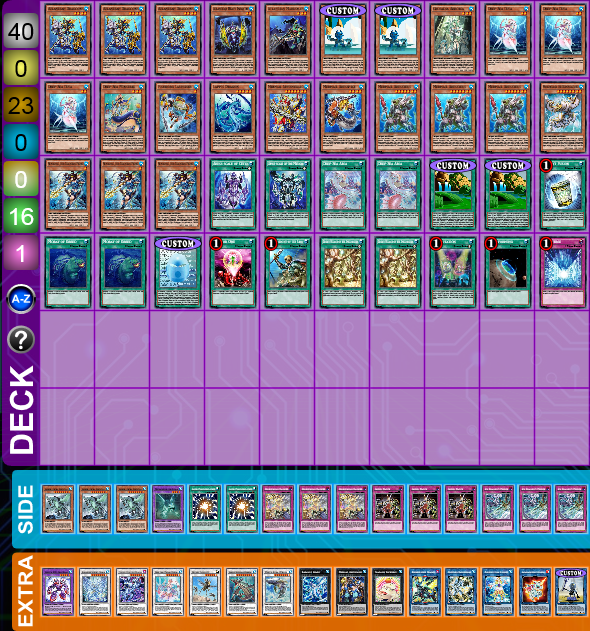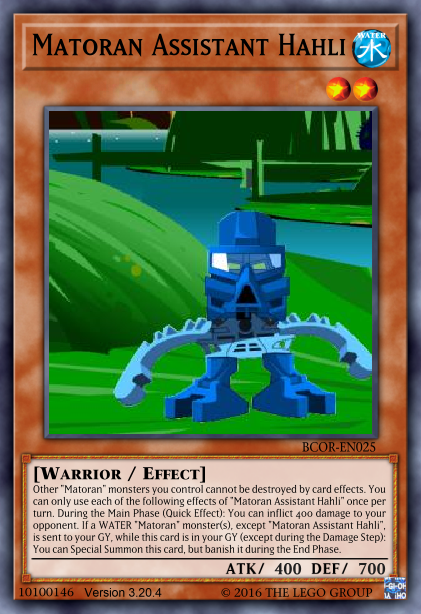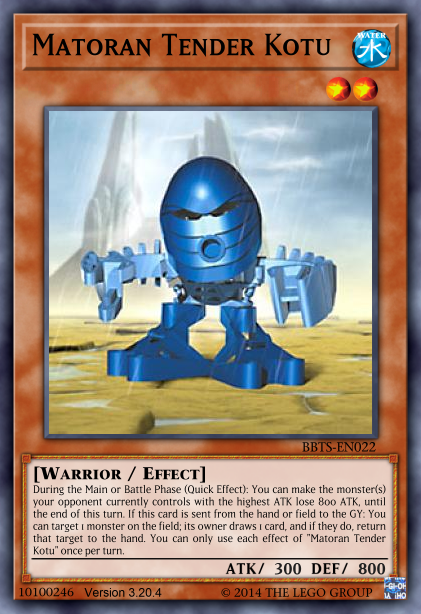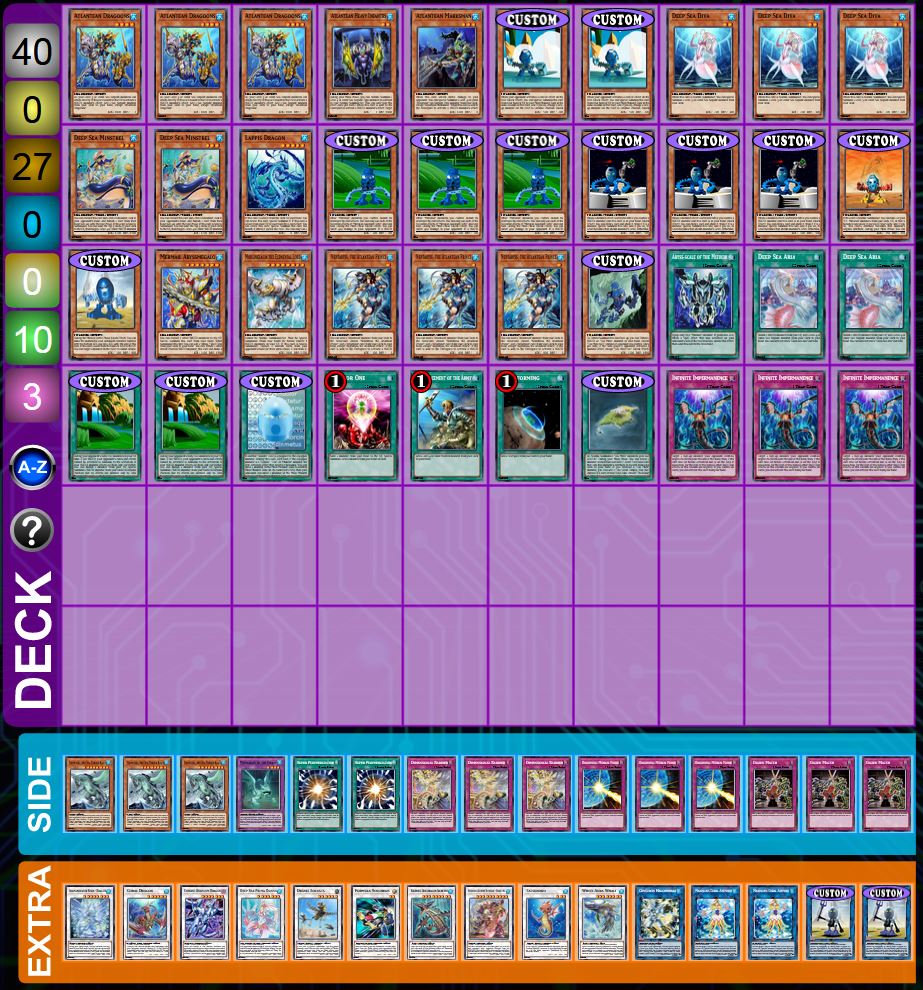For this year’s stupid thing I can only justify doing on this specific date, I have … donned my Kanohi Rau and produced some translations.
Specifically, this version includes all the Ga-Koro cards from BCOT in German, Japanese, and Matoric. If you’ve never heard of that last one, it’s a fan-made “reconstruction” of the Matoran language from which the various strange names in Bionicle originate, courtesy of outofgloom. Go check it out, it’s really well made.
Of course, it wouldn’t be a YGOPro Expansion if it wasn’t playable, so here’s some download links (each containing the full BCOT, but with only Ga-Koro actually translated):
Or just take a look in this brief demo video.
For the rest of this post, I’ll provide some notes on each language and the translation process, with the bulk of the focus of course falling on the Matoric PSCT grammar I had to construct from scratch to make this happen.
German
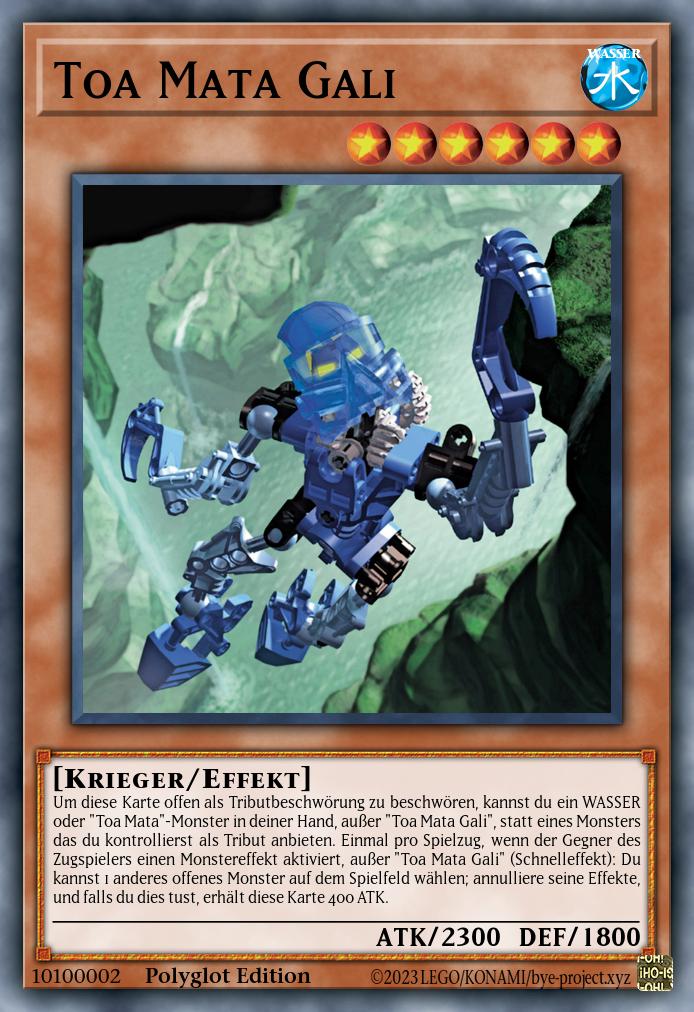
Toa Mata Gali
Effect MonsterLevel 6 | WATER Warrior | ATK 2300 / DEF 1800Um diese Karte offen als Tributbeschwörung zu beschwören, kannst du ein WASSER oder “Toa Mata”-Monster in deiner Hand, außer “Toa Mata Gali”, statt eines Monsters das du kontrollierst als Tribut anbieten. Einmal pro Spielzug, wenn der Gegner des Zugspielers einen Monstereffekt aktiviert, außer “Toa Mata Gali” (Schnelleffekt): Du kannst 1 anderes offenes Monster auf dem Spielfeld wählen; annulliere seine Effekte, und falls du dies tust, erhält diese Karte 400 ATK.
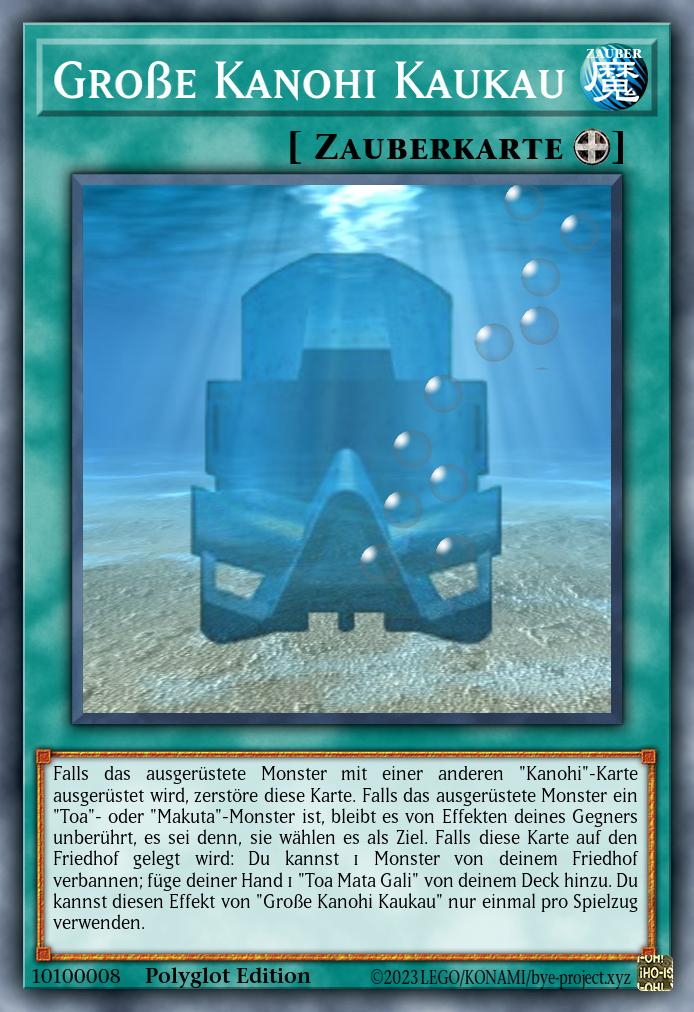
Große Kanohi Kaukau
Equip SpellFalls das ausgerüstete Monster mit einer anderen “Kanohi”-Karte ausgerüstet wird, zerstöre diese Karte. Falls das ausgerüstete Monster ein “Toa”- oder “Makuta”-Monster ist, bleibt es von Effekten deines Gegners unberührt, es sei denn, sie wählen es als Ziel. Falls diese Karte auf den Friedhof gelegt wird: Du kannst 1 Monster von deinem Friedhof verbannen; füge deiner Hand 1 “Toa Mata Gali” von deinem Deck hinzu. Du kannst diesen Effekt von “Große Kanohi Kaukau” nur einmal pro Spielzug verwenden.
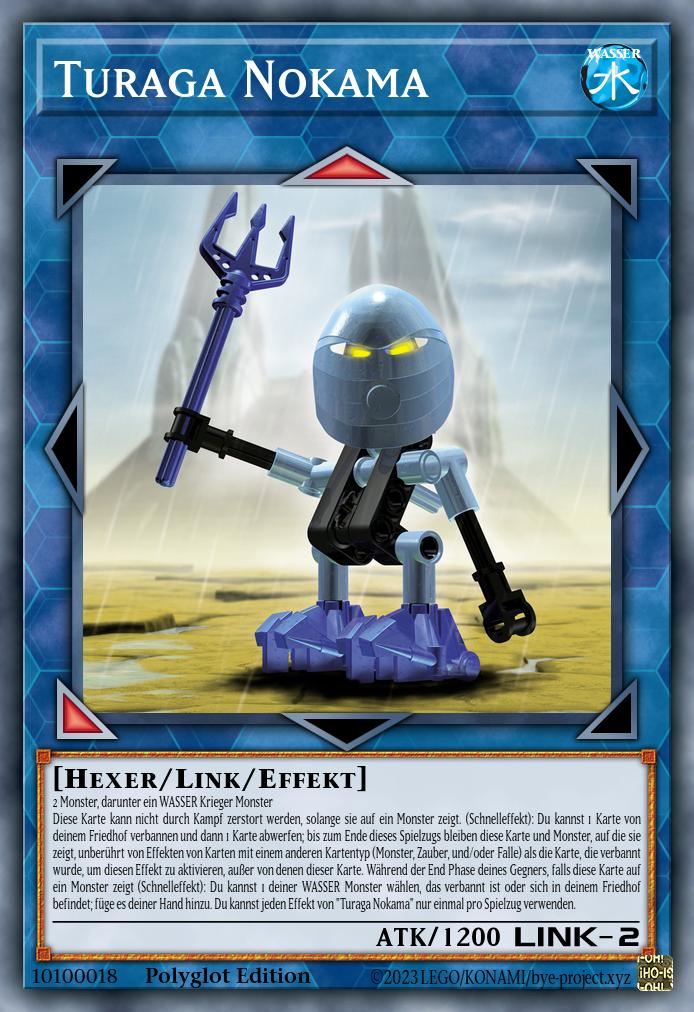
Turaga Nokama
Link Effect MonsterLink-2 [▲ ↙] | WATER Spellcaster | ATK 12002 Monster, darunter ein WASSER Krieger Monster
Diese Karte kann nicht durch Kampf zerstort werden, solange sie auf ein Monster zeigt. (Schnelleffekt): Du kannst 1 Karte von deinem Friedhof verbannen und dann 1 Karte abwerfen; bis zum Ende dieses Spielzugs bleiben diese Karte und Monster, auf die sie zeigt, unberührt von Effekten von Karten mit einem anderen Kartentyp (Monster, Zauber, und/oder Falle) als die Karte, die verbannt wurde, um diesen Effekt zu aktivieren, außer von denen dieser Karte. Während der End Phase deines Gegners, falls diese Karte auf ein Monster zeigt (Schnelleffekt): Du kannst 1 deiner WASSER Monster wählen, das verbannt ist oder sich in deinem Friedhof befindet; füge es deiner Hand hinzu. Du kannst jeden Effekt von “Turaga Nokama” nur einmal pro Spielzug verwenden.
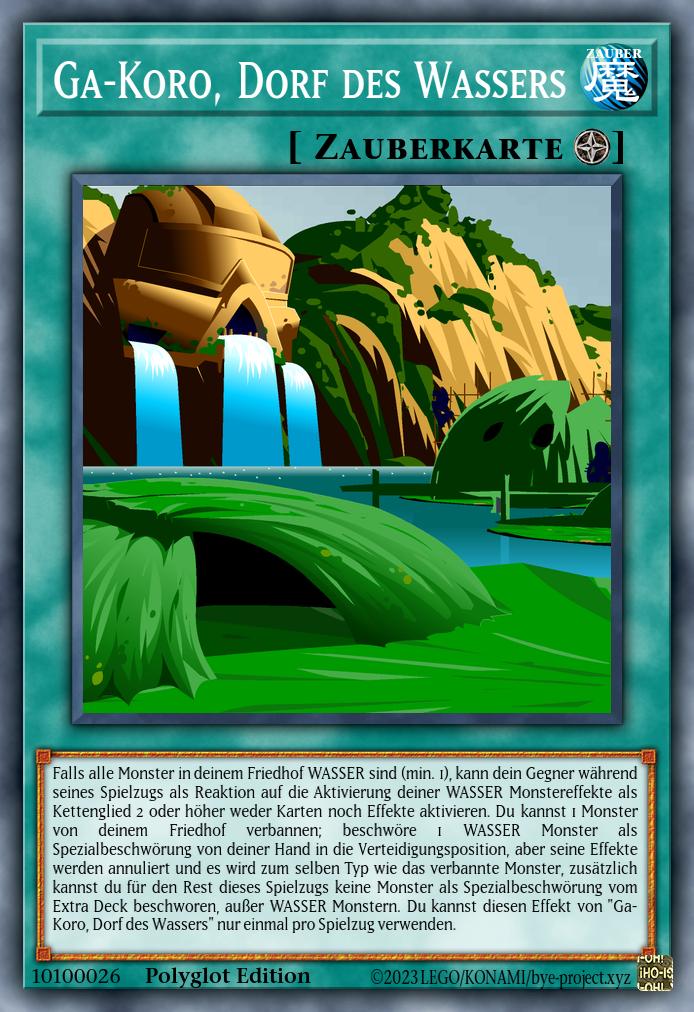
Ga-Koro, Dorf des Wassers
Field SpellFalls alle Monster in deinem Friedhof WASSER sind (min. 1), kann dein Gegner während seines Spielzugs als Reaktion auf die Aktivierung deiner WASSER Monstereffekte als Kettenglied 2 oder höher weder Karten noch Effekte aktivieren. Du kannst 1 Monster von deinem Friedhof verbannen; beschwöre 1 WASSER Monster als Spezialbeschwörung von deiner Hand in die Verteidigungsposition, aber seine Effekte werden annuliert und es wird zum selben Typ wie das verbannte Monster, zusätzlich kannst du für den Rest dieses Spielzugs keine Monster als Spezialbeschwörung vom Extra Deck beschworen, außer WASSER Monstern. Du kannst diesen Effekt von “Ga-Koro, Dorf des Wassers” nur einmal pro Spielzug verwenden.
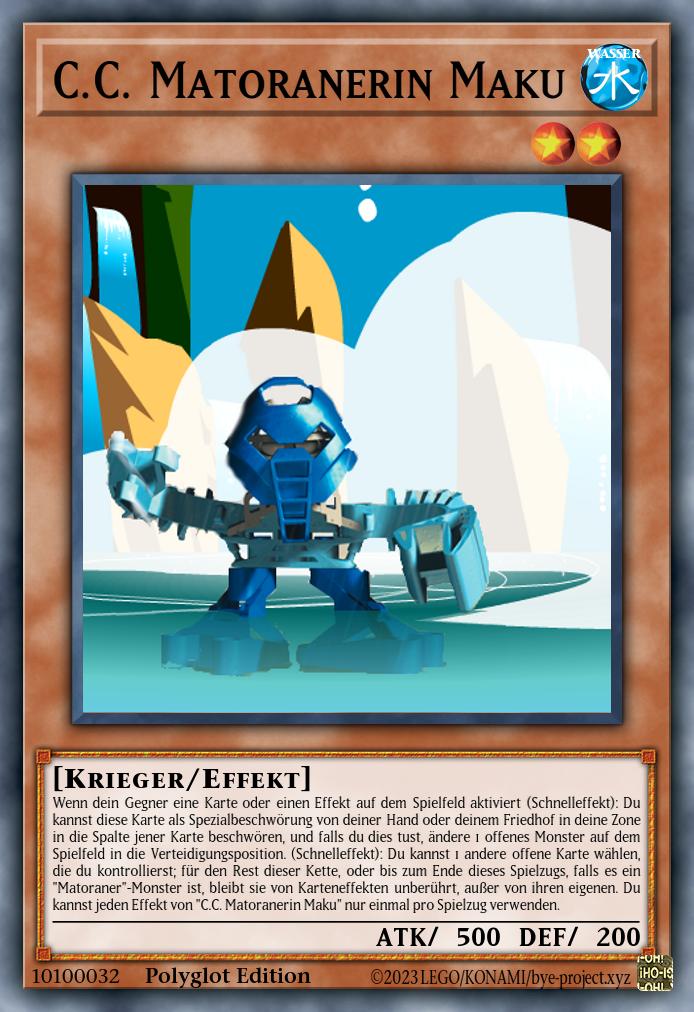
C.C. Matoranerin Maku
Effect MonsterLevel 2 | WATER Warrior | ATK 500 / DEF 200Wenn dein Gegner eine Karte oder einen Effekt auf dem Spielfeld aktiviert (Schnelleffekt): Du kannst diese Karte als Spezialbeschwörung von deiner Hand oder deinem Friedhof in deine Zone in die Spalte jener Karte beschwören, und falls du dies tust, ändere 1 offenes Monster auf dem Spielfeld in die Verteidigungsposition. (Schnelleffekt): Du kannst 1 andere offene Karte wählen, die du kontrollierst; für den Rest dieser Kette, oder bis zum Ende dieses Spielzugs, falls es ein “Matoraner”-Monster ist, bleibt sie von Karteneffekten unberührt, außer von ihren eigenen. Du kannst jeden Effekt von “C.C. Matoranerin Maku” nur einmal pro Spielzug verwenden.
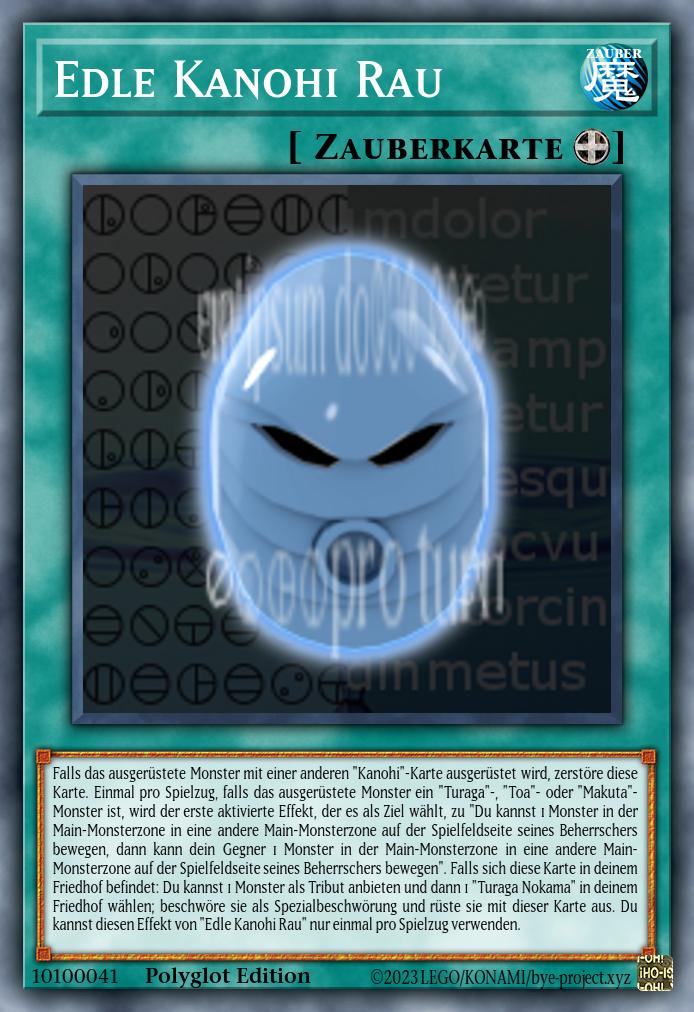
Edle Kanohi Rau
Equip SpellFalls das ausgerüstete Monster mit einer anderen “Kanohi”-Karte ausgerüstet wird, zerstöre diese Karte. Einmal pro Spielzug, falls das ausgerüstete Monster ein “Turaga”-, “Toa”- oder “Makuta”-Monster ist, wird der erste aktivierte Effekt, der es als Ziel wählt, zu “Du kannst 1 Monster in der Main-Monsterzone in eine andere Main-Monsterzone auf der Spielfeldseite seines Beherrschers bewegen, dann kann dein Gegner 1 Monster in der Main-Monsterzone in eine andere Main-Monsterzone auf der Spielfeldseite seines Beherrschers bewegen”. Falls sich diese Karte in deinem Friedhof befindet: Du kannst 1 Monster als Tribut anbieten und dann 1 “Turaga Nokama” in deinem Friedhof wählen; beschwöre sie als Spezialbeschwörung und rüste sie mit dieser Karte aus. Du kannst diesen Effekt von “Edle Kanohi Rau” nur einmal pro Spielzug verwenden.

Matoraner-Astrologin Nixie
Tuner Effect MonsterLevel 2 | WATER Warrior | ATK 400 / DEF 500Wenn ein Monstereffekt aktiviert wird, solange du ein WASSER Monster kontrollierst und sich diese Karte in deiner Hand befindet (Schnelleffekt): Du kannst 1 Karte ziehen und vorzeigen, dann, falls es ein Monster ist, beschwöre diese Karte als Spezialbeschwörung, und falls du dies tust, wird ihre Stufe gleich der Stufe des vorgezeigten Monsters. Andernfalls wirf diese Karte ab. Falls diese Karte von der Hand oder dem Spielfeld auf den Friedhof gelegt wird und du keine Zauber/Fallen in deinem Friedhof hast: Du kannst 1 Zauber/Falle von deinem Deck auf den Friedhof legen. Du kannst jeden Effekt von “Matoraner-Astrologin Nixie” nur einmal pro Spielzug verwenden.
Being the only one of these languages that I actually speak, this one was far and away the easiest to figure out. I pretty much just sat down and translated, though since PSCT is its own beast, there was also a good bit of cross-referencing with the German TCG card database involved.
One somewhat interesting aspect here is the handling of gendered nouns and their corresponding pronouns. For some reason it appears that players, who are referred to with “they” in all modern English card texts, are simply assumed to be male, but when it comes to cards, German PSCT does go out of its way to match the language with the name’s grammatical gender (such as in T.G. Hellebardenkanone/Angriffsmodus). While I couldn’t find a clear precedent on how that works when the name is a completely made-up personal name, like “Turaga Nokama” on the Kanohi Rau, as a Bionicle lore nerd I obviously can’t miss an opportunity to clarify that the blue ones are in fact girls. So the Rau revival effect does properly refer to Nokama with “sie”.
Also, check the alt art on the Rau I included to go with the occasion. Being able to get high-quality Kanohi images at any angle from Studio does open up some nice possibilities in that department, even for my artistically challenged self.
Japanese

ツラガ・ノカマ
Link Effect MonsterLink-2 [▲ ↙] | WATER Spellcaster | ATK 1200戦士族・水属性モンスターを含むモンスター2体
このカード名の②③の効果はそれぞれ1ターンに1度しか使用できない。①:このカードのリンク先にモンスターが存在する限り、このカードは戦闘では破壊されない。②:自分・相手ターンに、自分の墓地からカード1枚を除外し、手札を1枚捨てて発動できる。このカード及びこのカードのリンク先のモンスターはターン終了時までこの効果を発動するために除外したカードと種類(モンスター・魔法・罠)が異なるこのカード以外のカードの効果を受けない。③:相手エンドフェイズにこのカードのリンク先にモンスターが存在する場合、自分の墓地のモンスター及び除外されている自分のモンスターの中から、水属性モンスター1体を対象として発動できる。そのモンスターを手札に加える。

C.C.マトラン・マックー
Effect MonsterLevel 2 | WATER Warrior | ATK 500 / DEF 200このカード名の①②の効果はそれぞれ1ターンに1度しか使用できない。①:相手がフィールドのカードの効果を発動した時に発動できる。このカードをその縦列の自分フィールドに手札・墓地から特殊召喚し、フィールドの表側表示モンスター1体を選んで守備表示にする。②:自分・相手ターンに、このカード以外の自分フィールドの表側表示のカード1枚を対象として発動できる。そのカードはチェーン終了時まで、「マトラン」モンスターだった場合ターン終了時まで、自身以外のカードの効果を受けない。

ノーブル・カノイ・ラウ
Equip Spellこのカード名の③の効果は1ターンに1度しか使用できない。①:装備モンスターが他の「カノイ」カードを装備した場合にこのカードを破壊される。②:装備モンスターが「トア」、「ツラガ」、「マクタ」モンスターの場合、1ターンに1度だけ、装備モンスターを対象とする効果は「メインモンスターゾーンのモンスター1体の位置をそのコントローラーのフィールドの他のメインモンスターゾーンに移動できる。その後、相手はメインモンスターゾーンのモンスター1体の位置をそのコントローラーのフィールドの他のメインモンスターゾーンに移動できる」となる。③:このカードが墓地に存在する場合、自分フィールドのモンスター1体をリリースし、自分の墓地の「ツラガ・ノカマ」1体を対象として発動できる。そのモンスターを特殊召喚し、このカードを装備する。
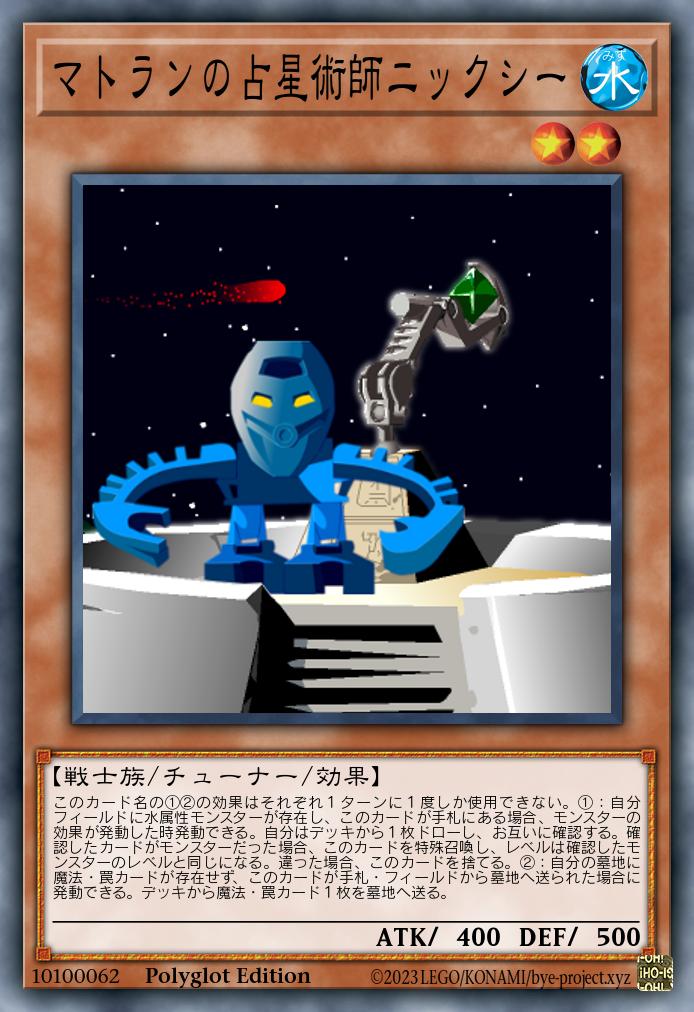
マトランの占星術師ニックシー
Tuner Effect MonsterLevel 2 | WATER Warrior | ATK 400 / DEF 500このカード名の①②の効果はそれぞれ1ターンに1度しか使用できない。①:自分フィールドに水属性モンスターが存在し、このカードが手札にある場合、モンスターの効果が発動した時発動できる。自分はデッキから1枚ドローし、お互いに確認する。確認したカードがモンスターだった場合、このカードを特殊召喚し、レベルは確認したモンスターのレベルと同じになる。違った場合、このカードを捨てる。②:自分の墓地に魔法・罠カードが存在せず、このカードが手札・フィールドから墓地へ送られた場合に発動できる。デッキから魔法・罠カード1枚を墓地へ送る。
The difficulty level got a lot higher here, what with my understanding of Japanese only being good enough to reasonably navigate the card database and Frankenstein together relevant effects. And there were also the barriers of a different writing system and different basic card text structure to overcome. But clearly I managed, so here we are.
To figure out how names should be written, I took a look around archives of the official Japanese Bionicle website as well as some fan sites that popped up in search. Most of it was just a straightforward representation of the sounds in katakana, but one little surprise was that Kanohi apparently becomes カノイ (that is, the “h” is dropped). For Nixie’s job description of “Astrologer”, I had to consult an actual dictionary too, ending up with 占星術師. Googling it brings up FF14 stuff, so I assume it’s appropriately mystical. For a while I also considered spicing up some of the boring katakana names with meaningful (read: chuuni) kanji representations and ruby text, but that idea was dropped in favour of keeping card image generation simple.
As for the card text structure, I do love the numbered effects and how easy it makes all varieties of HOPT clauses. On the other hand, our PSCT generally feels like it flows much better with the way it’s clearly sectioned by punctuation and can leave a lot of boilerplate phrases unsaid thanks to that. Tradeoffs.
Matoric
Alright, welcome to the deep end. Not only did I not know anything about this language when I started, but there was also zero documentation or precedent on how to apply it in Yugioh card text. There was no cross-referencing or Frankensteining here, just raw, unfiltered, phrase-by-phrase, sentence-by-sentence translation. On that note, a huge shout out to the language’s original creator outofgloom – not only for writing the Matoric documents that made this at all possible, but also for taking the time to personally answer several questions I couldn’t figure out on my own.
The result is a PSCT variant that looks quite similar to the Matoric language, but technically should be considered distinct from it for a number of reasons:
- Punctuation and general effect layout has mostly been retained from the English texts, even where it doesn’t quite match with conventions of Matoric grammar.
- The vocabulary for game mechanics and some other things are my own additions that more or less derive from official terms, but may well be contradicted by future dictionaries.
- I’ve incorporated some grammatical concepts from unpublished WIP material that I obtained through communication with outofgloom, so those might also change by the time the language gets its next proper update.
- And of course, it’s always possible that I’ve simply misunderstood a grammar rule or two and ended up with the Matoran equivalent of Engrish.
So, we are looking at a base Matoric language and a presumably quite similar “PSCT Matoric”, but explaining the core grammar or even just all the modifications made to accommodate card text would turn out far too long and dry. If you’re interested in the former, I once again refer you to the official resources instead, and for the latter, I’ll do my best to quickly list out the points of note for each card.

Toa Mata Gali
Effect MonsterLevel 6 | WATER Warrior | ATK 2300 / DEF 1800To Tribute Summon this card face-up, you can Tribute a WATER or “Toa Mata” monster in your hand, except “Toa Mata Gali”, instead of a monster you control. Once per turn, when the turn player’s opponent activates a monster effect, except “Toa Mata Gali” (Quick Effect): You can target 1 other face-up monster on the field; negate its effects, and if you do, this card gains 400 ATK.

Toa Mata Gali
Effect MonsterLevel 6 | WATER Warrior | ATK 2300 / DEF 1800Paro’o-sapo za okhau-ido ihu ya ke, ke a manas GAHA “Toa Mata” su (“Toa Mata Gali” va) arnoro’u po, manas ya-uka borau-za va za okhau ya vo. On agiro u takaro, e’e alhii agiro ai-rupu ta manas-akiro “Toa Mata Gali” va za lutu ya po (Kah-Akiro): Uka ihu-ku-manas nuala po 1 za aro ya vo ke; akiro’ai rya, e apaia paro’o-sapo ai-ATK za peha 400 ya ke.
The most complicated part of Gali is actually the special Tribute Summoning condition, structured as “To […] you can Tribute […] instead of […]”, a combination of two grammatical features not explicitly covered anywhere. So I went and asked outofgloom directly, to which he kindly provided me the following solutions:
- [do X] ke ke [do Y] – “To do X, do Y”; this is a pretty roundabout phrasing based on conditional markers that more directly translates to “conditioning of doing X is conditioned by doing Y”. A further layer of complexity arises from the fact that Tribute Summoning Gali this way is optional, which I tried to represent by attaching the “ability” marker vo to the full sentence – making “conditioning of doing X can be conditioned by doing Y”.
- a [X] [Y] va – “X instead of Y”; a simple repurposing of a basic coordinative marker meaning “but not” or “except”. Which brings some unfortunate overlap with the “except “Toa Mata Gali”” in the same sentence, so I moved that into parentheses for clarity.
Homecooked vocabulary in this effect includes sapo (“card”; lit. “thin stone”, based on the idea that a paperless culture would play card games on stone tablets), okhau (“Tribute”; from okh hau u “without preservation”), ido (“Summon”; shortened form of ika do ya “to call a being”) and ihu (“face-up”; lit. “upward”, mirroring iru for “downward”, plus it’s pretty funny to have a mountain with that name).
The other effect is comparatively simple in grammar, but makes significant use of those bits of artistic license that separate the language of these cards from “raw” Matoric. Right at the start you have on agiro u takaro (“once per turn”; lit. “once inside of a turn”), which is probably grammatical nonsense but serves as a nice way to keep the OPT clause together. And at the macro level, I’ve retained the punctuation of English PSCT since that saves me a lot of text to translate.
That means we begin with a “when” activation timing represented by e’e [X] po, the first half of a conditional construct with explicit present tense to distinguish from “if”. After the colon, this is followed by targeting instructions, which close out the conditional with [Y] ke, and finally the actual effect with its “and if you do” conjunction. Said conjunction simply translates to e apaia (“if successful”), allowing it and the second half of the effect to occupy a nice standalone conditional clause.
Lots of original vocab here too – agiro (“turn”; lit. “game cycle” from the root word algis “game” and rho “cycle”), takaro (“once”; combination of taka “one” and aro “discrete unit”) , rupu (“opponent”; from ru-apu “not-friend”) and akiro (“effect”; from akiro’a “originating from work”).
Finally, one might wonder why the Warrior Type is translated to Toh. The reason is simply that the only word in the dictionaries with a translation in that direction is Toa (“hero”, “warrior”), which is obviously loaded with a lot more meaning than what we want here. So as a cheap trick I just changed it ever so slightly, perhaps someone with actual knowledge of linguistics could argue this is some kind of archaic form that retained generic use even after the modern Toa split from it.

Great Kanohi Kaukau
Equip SpellIf another “Kanohi” card becomes equipped to the equipped monster, destroy this card. If the equipped monster is a “Toa” or “Makuta” monster, it is unaffected by your opponent’s card effects, unless they target it. If this card is sent to the GY: You can banish 1 monster from your GY; add 1 “Toa Mata Gali” from your Deck to your hand. You can only use this effect of “Great Kanohi Kaukau” once per turn.

Kanohi Nui Kaukau
Equip SpellE’e haran-manas aha ku-sapo “Kanohi” ran ai ta, paro’o-sapo za ikhya ke. E’e haran-manas manas “Toa”, “Makuta” su ai, ohi a hiki rupu ai-akiro yaru-aka iza aro ru ke. E’e bakuala ko paro’o-sapo za ivo ya: Uka manas bakuala’u po 1 za khu ya vo ke; at sapuru’u a arnoro’u ko “Toa Mata Gali” 1 za ivoya. On agiro u uka paro’o-akiro ai-“Kanohi Nui Kaukau” za ran 1 ko ya voru.
The standard Kanohi exclusion effect is clearly a conditional structure that translates straight to e’e [X] [Y] ke, so the more interesting detail of grammar here is that I translated “A becomes equipped to B” as an equative sentence with the inceptive marker ta, making it more literally “B begins to be equipped with A” (the switch from “to” to “with” is just because it makes flipping the relation easier, but that’s not relevant here). I’ve decided to adopt haran (“armor”) as the term for the Equip mechanic, and so the marker for the “equipped with” relationship is somewhat randomly derived from that as aha_ran. The use of ikhya for the imperative of “destroy” might technically not be correct – one dictionary lists ikhi as “destruction”, but another has just khi ya as “destroy”. However, with the word for banishing being khu, using the shorter version would lead to “destroy” and “banish” not being distinguishable when their end vowel is dropped in an imperative sentence, which would be a much bigger problem.
The on-field protection effect is notable for its use of a subordinate clause in “unless they target it”, which I paraphrased to “that do not target it”. Subordination is the part of the Matoric language that I am most likely to have screwed up in my translations, but to my best understanding in this case it works by taking the sentence akiro ta iza aro yaru (“The effect(s) do(es) not target it”), lifting its subject akiro (marked by ta) outside and replacing it with the placeholder aka, and turning the original sentence’s suffix yaru into a prefix so that the resulting phrase can be used as a modifier. Hence, akiro yaru-aka iza aro should mean “effects that do not target it”.
The unaffectedness by those effects is expressed using a negated equative sentence ending in ru, with the help of the marker a hiki _ (“manipulated by”). That means a literal translation would be “it is not manipulated by effects that do not target it” – sounds about right!
As for the GY effect, it showcases both the use of Location/Direction markers in sentences dealing with movement and the Matoric names of various in-game locations. The activation condition is bakuala ko paro’o-sapo za ivo ya (“this card moves forward to the GY”), where the ko marker lets us conveniently keep a clear distinction from “returning to the GY” (which would be marked by nu “moves backward to”). And what you do is at sapuru’u a arnoro’u ko “Toa Mata Gali” za ivoya (“move “Toa Mata Gali” originating from your Deck forward to your hand”).
The location names I made up are bakuala (“Graveyard”; from kui-vala “loss-place”, prefixed by an Agoric stem ba- “death” because there’s no known direct word for that in Matoric and I really wanted it included explicitly) and sapuru (“Deck”; from sapo-huru “card elevation”). Arnoro for hand is just the standard term for the body part, didn’t bother coming up with anything card game specific.

Turaga Nokama
Link Effect MonsterLink-2 [▲ ↙] | WATER Spellcaster | ATK 12002 monsters, including a WATER Warrior monster
Cannot be destroyed by battle while it points to a monster. (Quick Effect): You can banish 1 card from your GY, then discard 1 card; until the end of this turn, this card and monsters it points to are unaffected by the effects of cards with a different card type (Monster, Spell, and/or Trap) than the card banished to activate this effect, except this card’s. During your opponent’s End Phase, if this card points to a monster (Quick Effect): You can target 1 of your WATER monsters that is banished or in your GY; add it to your hand. You can only use each effect of “Turaga Nokama” once per turn.

Turaga Nokama
Link Effect MonsterLink-2 [▲ ↙] | WATER Spellcaster | ATK 1200Manas 2 ai-ohi po manas GAHA Toh
E’e ka manas a paro’o-sapo ai, paro’o-sapo za barra-ikhi ya voru ke. (Kah-Akiro): O’o uka sapo bakuala’u po 1 za khu ya, uka sapo 1 osapu ya ka vo; paro’o-agiro ai-oko po, paro’o-sapo manas ai-ka’a ohi no a hiki sapo ya-aka ku-atu (Manas, Doka, Ilhura no/su) za ima te sapo paro’o-akiro lutu ya ke ke ya-khu-za nu ai-akiro paro’o-sapo ai-akiro va ru. E’e rupu ai-End-Phase po ai, ka manas a paro’o-sapo ai (Kah-Akiro): Uka manas’u GAHA khu bakuala’u su po 1 za aro ya vo; arnoro’u ko ivoya. On agiro u uka aro-akiro ai-“Turaga Nokama” ran 1 ko ya voru.
Okay, so on this one I really have to hold back, because the moment I start rambling about all the things in Nokama’s translation is the moment this article gets out of hand.
It starts with the materials line, which is paraphrased to “2 monsters among whom there is a WATER Warrior monster” and translated via subordinate clause. Then the battle protection has ka_a (“pointing to”) used in reference to Link Arrows and features the term barra-ikhi (“battle-destroyed”), whose similarity to Barraki probably makes for quite the pun in-universe.
And with the main Quick Effect, we get into the real meat of the matter. The cost and targeting clause includes an original coordination marker o_ka that connects things in sequence (i.e., “then”), as well as the fancy term osapu (“discard”; from ohsapo’u “separation from card”). Once you start resolving, you have to apply something until the end of the turn, or paro’o-agiro ai-oko po (“during the future of this turn”), followed by identifying the “monsters [this card] points to”. What sounds like a simple task for a subordinate clause is immensely complicated by the fact that the clause being subordinated is an equative sentence without a real subject or object, so how do we signify that the “monsters” it is modifying goes within the ka_a marker? The answer I settled on is “not at all”, simply leaving the marker empty and hoping the gap makes it obvious enough how it should be read.
As if that wasn’t enough, the next task is to state “cards with a different card type from […]”, or “cards that have a different card type than […]”, if we want to phrase it with a subordinate clause. This, however, is a rare sentence where that subordination isn’t even the biggest hurdle – it’s the fucking from. To tackle this, I had to employ a sentential marker right out of the previously mentioned WIP materials: _te_, translatable to various things including “relative to”. So, by extending the subordinate clause of “having a different card type” with te X, we can express the card type should be different “relative to X”. But wait, what’s X? Well, X is “the card (that was) banished to activate this effect”.
Ooohhh boy. That is a “[did X] to [do Y]” construction, which as seen back with Gali would already be a headache to do straight. And now it has to be bent into its subordinated form as well. What I settled on, without any real idea whether it’s right or not, is sapo paro’o-akiro lutu ya ke ke ya-khu-za nu – using the whole purpose-expressing structure as a modifier on the card, but only actually writing the directly relevant part (“the card was banished”) as a desentential unit ya-khu-za nu.
The interesting terminology are obviously the card types. Manas (“Monster”) is obligatory as a canon term, Doka (“Spell”) comes from do ka ya (“speak with energy”; the idea being that literal magic would mostly set itself apart from standard MU powers by its verbal incantations or, well, Spells), and Ilhura (“Trap”) from ilahu tura (“suprising binding”).
And during the End Phase, which is a term imported unchanged to Matoric just like it isn’t any different in German or Japanese, you just get to “move a card forward to your hand” once more.
Phew.

Ga-Koro, Village of Water
Field SpellDuring your opponent’s turn, if all monsters in your GY are WATER (min. 1), your opponent cannot activate cards or effects in response to the activation of your WATER monster effects as Chain Link 2 or higher. You can banish 1 monster from your GY; Special Summon 1 WATER monster from your hand in Defense Position, but its effects are negated and it becomes the same Type as the banished monster’s, also you cannot Special Summon monsters from the Extra Deck for the rest of this turn, except WATER monsters. You can only use this effect of “Ga-Koro, Village of Water” once per turn.

Ga-Koro, Gaha Ai-Koro
Field SpellE’e rupu ai-agiro po ai bakuala’u po maa-manas GAHA (ve 1 u) ai, manas-akiro’u GAHA ai-lutu ve ivai-aro 2 u ta rupu u sapo akiro sa za lutu yai voru ke. Uka manas bakuala’u po 1 za khu ya vo; a’a at arnoro’u a ka hau a manas GAHA 1 za fe-idoya o’o akiro’ai za ru ya vah’ai manas ya-khu-za nu ai-vah ai ta na va, paro’o-agiro ai-oko po at sapuru va a manas ru-GAHA za fe-ido ya voru. On agiro u uka paro’o-akiro ai-“Ga-Koro, Gaha ai-Koro” ran 1 ka ya voru.
This one has the concept of “in response to”, which had me quite stumped until I was pointed towards causative sentences that express meanings such as “X makes Y do Z” (X ta Y Z yai). Adapting them for this complex use case took a bit of (guess)work, but what I ended up with essentially translates to “The activation of your WATER monster effects as Chain Link 2 or higher cannot make your opponent activate cards or effects”.
The new term Chain Link translates to ivai-aro (“linked structure item”; ivai “Chain” from ivo-vai “linkage-arrangement”), and what’s also interesting is my repurposing of Location/Direction markers to express relations on numbers. This was already subtly visible in all the HOPT clauses, but this effect does itself include two instances of ve_u (“extending from”) around a number, meaning “min.” and “or higher”, respectively – basically >=.
The other effect has nothing weird going on with its grammar for once, but introduces a bit of new vocabulary as well, such as fe-ido (“Special Summon”; from fehi “innovation”, in the sense that it’s an “unusual” Summon), ka hau a (“in Defense Position”; lit. “oriented towards defense”), vah (“Type”; lit. “herd, swarm”), and sapuru va (“Extra Deck”; lit. “non-primary Deck”).

C.C. Matoran Maku
Effect MonsterLevel 2 | WATER Warrior | ATK 500 / DEF 200When your opponent activates a card or effect on the field (Quick Effect): You can Special Summon this card from your hand or GY to your zone in that card’s column, and if you do, change 1 face-up monster on the field to Defense Position. (Quick Effect): You can target 1 other face-up card you control; for the rest of this Chain, or until the end of this turn if it is a “Matoran” monster, it is unaffected by card effects, except its own. You can only use each effect of “C.C. Matoran Maku” once per turn.

A.A. Matoran Maku
Effect MonsterLevel 2 | WATER Warrior | ATK 500 / DEF 200E’e nuala po rupu ta sapo akiro su za lutu ya po (Kah-Akiro): At arnoro’u bakuala’u su a vala’u on otu’u-sapo ai-zasa u ko uka paro’o-sapo za fe-ido ya vo, e apaia ihu-manas nuala po 1 za hau-kama ko itya ke. (Kah-Akiro): Uka ihu-ku-sapo ya-uka borau-za 1 aro ya vo; paro’o-ivai ai-oko, e manas “Matoran” ai paro’o-agiro ai-oko ke su, ohi a hiki akiro akiro’ai va ru. On agiro u uka aro-akiro ai-“A.A. Matoran Maku” ran 1 ko ya voru.
The most interesting portions that haven’t been touched on already are probably the “to your zone in that card’s column” and “for the rest of this Chain, or until the end of this turn”. The former can be handled with nested Location/Direction markers [vala’u [on otu’u-sapo ai-zasa u] ko] (“forward to your zone inside of that card’s column”) , and the other by appending the su (“or”) coordination marker to a conditional-marked unit to make that “or […] if”.
Defense Position appears for the second time, but this time with a more complete name hau-kama (“defensive orientation”; kama derived from marker ka_a “oriented toward”), and we also encounter zasa (“column”; based on tsasus from the Agoric dictionary).
You might also be wondering why C.C. becomes A.A. – that’s because Chronicler’s Company translates to something like Amaja-Apu. The alliteration survives!

Noble Kanohi Rau
Equip SpellIf another “Kanohi” card becomes equipped to the equipped monster, destroy this card. Once per turn, if the equipped monster is a “Turaga”, “Toa”, or “Makuta” monster, the first activated effect that targets it becomes “You can move 1 monster in the Main Monster Zone to another Main Monster Zone on its controller’s field, then your opponent can move 1 monster in the Main Monster Zone to another Main Monster Zone on its controller’s field”. If this card is in your GY: You can Tribute 1 monster, then target 1 “Turaga Nokama” in your GY; Special Summon it and equip it with this card. You can only use this effect of “Noble Kanohi Rau” once per turn.

Kanohi Lui Rau
Equip SpellE’e haran-manas aha ku-sapo “Kanohi” ran ai ta, paro’o-sapo za ikhya ke. On agiro u takaro, e’e haran-manas manas “Turaga”, “Toa”, “Makuta” su ai, lutu-akiro ya-aka iza aro takua “O’o uka manas manas ai-vala ga po 1 za manas ai-ku-vala ga boraua’ai ai-nuala po ko ivo ya vo, rupu ta manas manas ai-vala ga po 1 za manas ai-ku-vala ga boraua’ai ai-nuala po ko ivo ya vo ka” ai ta ke. E’e bakuala’u po paro’o-sapo ai: O’o uka manas 1 za okhau ya, uka “Turaga Nokama” bakuala’u po 1 za aro ya ka vo ke; o’o iza fe-idoya, aha paro’o-sapo ran ai ta na. On agiro u uka paro’o-akiro ai-“Kanohi Lui Rau” za ran 1 ko ya voru.
This card’s name actually includes the one piece of vocabulary I’ve decided to borrow from the older version of the Matoran Language that was not yet called Matoric: Lui for “Noble”. In the context of Kanohi, it’s just really nice how that rhymes with Nui for “Great”.
The on-field replacement effect is structured around a “becomes”, which is a verb that translates neatly not into a full verbal sentence, but rather an inceptive equative sentence (i.e., one that ends in ai ta – a “starts to be”). The effect in quotation marks is nothing shocking at this point, just two optional actions linked with “then”, but it does introduce the term I’ve chosen to use for “Main Monster Zone”: manas ai-vala ga (“primary zone of monsters”; the ga particle is a made-up one to contrast the va already seen in the translation of “Extra Deck”). Notably, the core of this phrase is the possession-marked vala, so further modifiers like “other” can attach directly to it and yield interesting results such as manas ai-ku-vala ga.
The GY effect showcases the basic “and” conjunction, which is adapted directly by use of the o_na marker. The final portion of the sentence is yet another inceptive equative sentence replacing a verb, paraphrasing “equip it with this card” to “it starts to be equipped with this card”.

Matoran Astrologer Nixie
Tuner Effect MonsterLevel 2 | WATER Warrior | ATK 400 / DEF 500When a monster effect is activated while you control a WATER monster and this card is in your hand (Quick Effect): You can draw 1 card and show it, then if it is a monster, Special Summon this card, and if you do, its Level becomes the shown monster’s Level. Otherwise, discard this card. If this card is sent from the hand or field to the GY, and you have no Spells/Traps in your GY: You can send 1 Spell/Trap from your Deck to the GY. You can only use each effect of “Matoran Astrologer Nixie” once per turn.

Nixawa-Matoran Nixie
Tuner Effect MonsterLevel 2 | WATER Warrior | ATK 400 / DEF 500E’e manas-akiro za lutu ya po, uka manas GAHA za borau ya, arnoro’u po paro’o-sapo ai (Kah-Akiro): O’o o’o uka sapo 1 za kiva ya iza aku ya na vo ke. E’e ohi manas ai, paro’o-sapo za fe-idoya, e apaia bahtu’ai manas aku ai-bahtu ai ta ke ke ka. E’e ohi manas ru, paro’o-sapo za osapya ke ka. E’e at arnoro nuala su a bakuala ko paro’o-sapo za ivo ya, bakuala’u po Doka/Ilhura ru: At sapuru’u a bakuala ko uka Doka/Ilhura 1 ivo ya vo ke. On agiro u uka aro-akiro ai-“Nixawa-Matoran Nixie” ran 1 ko ya voru.
Nixie closes out the set, but not without some grammatical quirks of her own. That already begins with the card name that lists her occupation and name, which ends up sounding a bit redundant since Matoric often interprets Matoran names as relating to that individual’s Duty. To slightly alleviate this, I went and attached a little marker -wa (“representative of”) to the job title.
The next eyecatcher lies still before the card text, namely Dehrab (“Tuner”; from dehi-raba “sound finalizer”), and once we finally get into the text, the weirdness continues. Not only is Nixie’s first effect a “when” with multiple requirements, it also operates on an if-else basis when it resolves, with a “then” thrown in for good measure. The result is some pretty involved nesting of o_ka and e_ke, crossing sentence boundaries in a way that might just lose more clarity than the boundaries themselves provide. Also somewhere in there is the term bahtu (“Level”; a generalization of bahtua “sea level”).
On the other hand, the final effect is almost laughably simple by comparison, to the point where I feel comfortable weaseling out of an explanation by simply speaking the magic words: Left as an exercise to the reader.
Final Notes
So does this mean the project is officially going multilingual? Absolutely not, there’s no way I have the time to do this on any kind of larger scale. For the foreseeable future, it’s going to remain a one-time April Fools’ thing.
However, in putting this together, I was able to set the stage fairly well for supporting more than one language in the creation and release processes. As you can see, the card viewer blocks have no problem displaying the information (though I have not bothered to translate card types, Attributes, Monster Types, etc), and I also succeeded in jury-rigging my installation of the ygopic card generator into outputting not only additional languages, but even using different fonts and layouts for Japanese and Matoric. Really, translation time is the only major problem stopping this from being an actual thing.
That is to say, if there’s a language in which you really want to see Bionicle cards, you could probably make it happen by just sending me finished translations 😉





